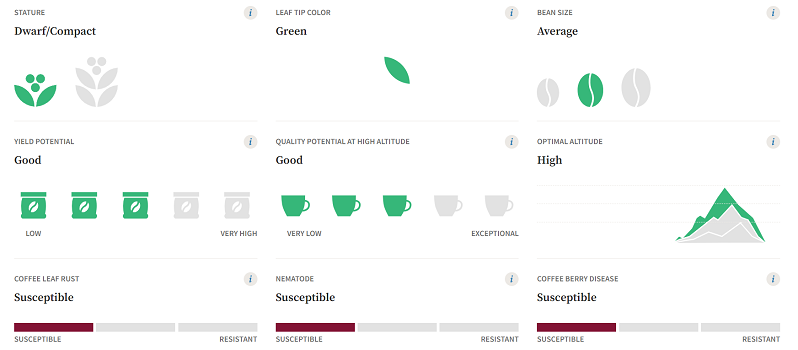For over four decades, the high-yielding Cataui variety has sustained coffee production across Central and South America.
This unassuming coffee variety pumps out bountiful harvests year after year. Though it doesn’t have the prestige of heirloom Bourbons or Geishas, Cataui’s hardy productivity has become a lifeline for many smallholder farms.
Cataui literally means “Very good” in an indigenous Brazilian language. In actuality, the cup quality is rather fair, not very good.
However, when grown in optimal conditions, this Brazilian-bred variety can shine, producing sweet, rich coffees that have even won Cup of Excellence awards.

What is Catuai Coffee Variety?
Catuai is a cross between two Arabica varieties – Mundo Novo, known for larger beans, and Caturra, a dwarf mutation of Bourbon prized for its higher yields and dwarf structure.
This coffee variety was developed by Instituto Agronomico (IAC) of Sao Paulo State in Brazil during the 1940s-50s to be highly productive while maintaining good cup quality.
The Catuai plant is quite compact and bushy like the Caturra, which allows for dense planting. But it produces at a much higher rate than Caturra or traditional Bourbon variety.
There are two main types of Catuai – yellow-fruited and red-fruited. The yellow produces a mellower and softer coffee drink while the red-fruited Catuai gives a brighter and more vibrant cup.

History and Cultivation of Catuai Coffee Variety
Catuai was first developed in 1949 at an agricultural institute in Campinas, Brazil. It was a cross between two existing Arabica varieties – Yellow Caturra and Mundo Novo. The researchers dubbed it H-2077 initially.
After extensive testing, Catuai was officially released in Brazil in 1972. It proved to be a high-yielding and resilient variety well suited to Brazilian growing conditions. Several genetic lines were further developed and some were extremely productive.
During the 70s and 80s, the cultivation of Catuai became more widespread in Latin America.
It was introduced to Honduras in 1979, where today it makes up nearly half of Arabica production.
Costa Rica started growing Catuai in 1985 and it comprises 20% of coffee output there now. Guatemala also adopted Catuai in the 1970s.
However, it hasn’t taken off as well in other Central American countries. The yields tend to be on par with varieties like Caturra rather than outstanding.

What are The Characteristics of Catuai Coffee?
Catuai coffee plants have a compact, bushy structure standing relatively short in stature. The small size suits dense spacing in Brazilian plantations, with up to double the normal density.

This plant has oval leaves that maintain a bright green color and the cherries have a nice oval shape.
Catuai Variety can also grow well at lower altitudes in Southeast Asian countries.
The short height and orderly shape facilitate easy management and mechanical harvesting – important advantages that aided Catuai’s widespread adoption in Brazil.
One downside is that Catuai is susceptible to the detrimental coffee leaf rust disease. Good cultural practices are essential to protect the plants.
While taking a typical 3 years to first harvest, once mature Catuai is prized for its vigorous productivity year after year.
What does Catuai Coffee taste like?
When optimally cultivated, Catuai tends to yield a mild to medium-bodied coffee. The flavor often has notes of chocolate, caramelized honey, and warm spices like nutmeg or sweetgrass. A medium to light roast helps bring out these sweeter qualities.
While not considered among the very top tier of Arabicas like Geisha or Bourbon, Catuai can produce a very pleasing cup when grown with care. It displays a wide range of attributes depending on the origin and processing method.
However, it also has some bitter and astringent elements like Robusta beans.
The finish has herbal and earthy tones and usually lacks the sparkling fruitiness of good-quality Arabica. Some find the aftertaste hollow or metallic.
While not the most nuanced, it can be a very drinkable coffee that highlights the skills of the farmer.
For many growers, Catuai hits that magical balance of productivity and flavor.
Discover other coffee bean varieties
Final Thoughts
And that wraps up our detailed overview of Catuai Coffee! I hope you now have a good sense of this unique variety – from its origins in Brazil to its typical flavor profile.
Let me know in the comments if you’ve tried a tasty Catuai coffee before. I’d love to hear about your experience with this widely grown workhorse!
Check out a guide on Different types of coffee beans
FAQs
What is the difference between Catuai and Caturra coffee?
Catuai and Catuura Coffee are both part of the Arabica varieties but have some differences.
Catuai was artificially created by crossing Mundo Novo and Caturra at a research institute in Brazil while Caturra itself originated as a natural mutation of Bourbon in Brazil
Catuai has a bright, acidic taste with bitter notes while Caturra offers a balanced and smooth flavor while.
Is Catuai Coffee Arabica or Robusta?
Catuai was crossed from two other pure Arabica varieties – Caturra and Mundo Novo. It does not actually contain any Robusta genetics.
The likely reason for the misconception is that Catuai can display some Robusta-like characteristics in the cup, such as a harsher body and some earthy notes.





